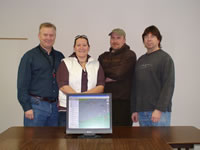 Exploration and mineral development information for the Municipality of Greenstone, encompassing Geraldton, Beardmore, Nakina and Longlac, is only a few mouse clicks away.
Exploration and mineral development information for the Municipality of Greenstone, encompassing Geraldton, Beardmore, Nakina and Longlac, is only a few mouse clicks away.
The Greenstone Mineral Development Initiative (GMDI) is helping junior miners do their homework. The municipality has consolidated mining and mineral information into a single interface using Google Earth. It also allows First Nations to see what is "going on in their own backyard," said Harry Kelly, Greenstone’s economic development co-ordinator.
Information that was once buried within layers of government websites is now readily accessible.
The community and its partners have compiled an online inventory of every old drill hole, abandoned mine and mineral deposit across two area townships. It’s now available in an easy-to-use format for mineral exploration companies to check out.
The GMDI project has components for both surface and underground exploration, the latter available in 3-D format.
For the surface information, a team of four IT programmers has compiled a multi-layered resource of more than 60 datasets organized into maps displaying historical, geological, electromagnetic, radiometric and other information.
"We wanted to try and keep the information in as neutral a format as possible so different viewers can tap in and make use of it," said IT administrator Jay Lucas. "One of the guiding principles is to keep it open source."
The 3-D underground information was complied by the Greenstone Economic Development Corporation.
Most of the mineral and exploration information was taken from the Ministry of Northern Development and Mines (MNDM) and the Ontario Geological Survey (OGS) websites. A total of 621 square miles were mapped for the pilot, encompassing Eva and Summers townships, areas described as "mature" within Greenstone’s larger 12,000-square mile boundaries.
Inquiries from the mining community spurred on the idea to consolidate Geraldton’s extensive mining history, said Greenstone’s mayor Michael Power.
Drill holes
"There were 13 operating gold mines. There was a lot of information around about drill-hole locations and their results, but nobody ever put it together."
Not only does this service make it easier for prospectors to explore in the Greenstone area, but also by having it online, others around the globe can see what is there, encouraging further development.
"In today’s world, the more clues you can provide to the exploration companies as to where they might more profitably search, the better," Power said.
With government funding support and an already strong IT infrastructure system in place through Greenstone’s Data Centre, there was a solid base to carry out the pilot project.
When the GMDI was launched last fall, the information was made available to geologists and mining companies working the area, and was promoted at mining symposiums in Thunder Bay and Sudbury.
To date, the feedback has been positive, particularly the ease of use and its ability to become a "quick reference tool." Other municipalities in northwestern Ontario have also expressed an interest.
Kelly anticipates the project will move into a second phase, which involves mapping the entire Greenstone area, although a final report was being assessed at press time.
"We have a sense of forward costing," Kelly said. "We’ve demonstrated and proven a value for money and its effectiveness. It has also demonstrated that we can retain young professional, highly educated people without them being lured to the major centres."
Kelly said they are brainstorming several ideas to keep the website and its information updated, relevant and financially sustainable.
www.greenstone.ca/gmdi


.jpg;w=120;h=80;mode=crop)